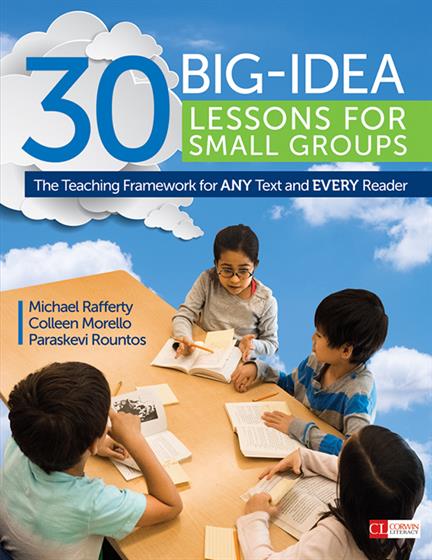Chapter 1. Big-Idea Groups: Scaffolded Reading Instruction Where Engagement Rules
The Ultimate Goal: Real Student Independence
Now Look at Student Independence During Big-Idea Groups
Four Facets of the Framework
How Big-Idea Groups Fit Within Other Small-Group Models
A Few Important Frameworks for Reading Closely
The Effective Environment Around Close Reading
What About Guided Reading and Strategic Reading?
What’s Ahead in This Book?
An Introductory Big-Idea Lesson
On Another Day: Adapting the Introductory Lesson With an Informational Text
The Great White Space
Chapter 2. The Lesson Design
The Tweaks to DRTA
Five Phases of the Lesson
Time Factors
When to Begin?
How Do They Fit Within Units of Study?
A Trial Run: The "Why" Behind Each Phase
Phase 1: Engaging
Phase 2: Discussing
Phase 3: Deep-See Thinking
Phase 4: Connecting
Phase 5: Assessing
Chapter 3. The Tools of Engagement
Interesting Texts
Collaboration
Autonomy
Real-World Instruction
Coherence
Expository Expectation Map
Important Versus Interesting
Ranking Characters
Ranking the Table of Contents
Semantic Word Ranking
Sketch-to-Stretch
Staircase Label
Vocabulary Karaoke
Teacher Involvement
Chapter 4. The 30 Lesson Planners
Chapter 5. Transferring Thinking Across the Day
Teacher Variety During Small-Group Instruction in the Reading Block
Agency: The Ability to Fly on Your Own
Connecting Conferring to Big Ideas Across the Day
Creating a Community Connecting to a Common Beacon
Making Homework a Matter Worth Doing
Chapter 6. Assessing Readers Within and Beyond the Group
The Rubric
Classroom Examples
Phase 1: Engaging
Phase 2: Discussing
Phase 3: Deep-See Thinking
Phase 4: Connecting
Responsible Talk
Assessing Speaking and Listening
Tracking Data to Help Drive Instructional Adjustments
Chapter 7. Useful Forms and Lists for Big-Idea Groups
Tactile Tool Forms
Box and Bullets
Character Karaoke
Charting the Chapters
Moving to Make Meaning
Pyramid of Perspectives
Semantic Circle
Tactile Chart
Vocabulary Karaoke
Topics Card
Other Big-Idea–Worthy Texts
Formative Assessment Data Sheet
Build Your Own Big-Idea Lessons Kit




